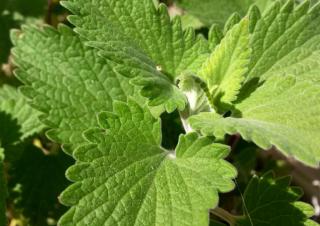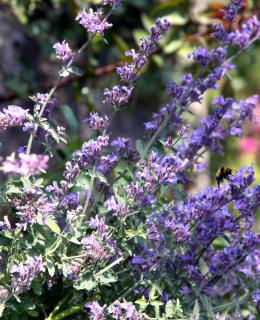

Nepeta is a cute blue-hued flower that is similar to both lavender and nettle. It adapts well to most climates, even cold and damp areas.
Name – Nepeta
Family – Lamiaceae
Type – perennial
Height – 16 to 32 inches (40 to 80 cm)
Exposure – full sun
Soil – light, well-drained
Blooming – May to October
Also called catgrass, catnip and even catmint because its leaves look like those of mint, it makes our feline friends a bit tipsy.
You can plant your nepeta starting in October and all the way to May-June, keeping a distance of 10 to 12 inches (25 to 30 cm) between plants.
Nepeta is propagated through sowing at the end of winter, in a crate and at a T° of more or less 65°F (18°C).
You can propagate nepeta in spring or fall through crown division.
This plant copes well with having a lot of sun, but must be watered in case of elevated temperatures or extended dry spell.
If growing it in pots, don’t wait for the soil to be completely dry before watering again; simply water often but in moderate amounts.
 Nepeta cataria leaves are preferably collected in the morning during its growth or vegetation phase.
Nepeta cataria leaves are preferably collected in the morning during its growth or vegetation phase.
Spring and summer is often when the harvest takes place, but it can also be conducted as long as your nepeta are densely furnished to prepare delicious nepeta infusions and herbal teas
Note that when you crumple nepeta flowers and leaves, they produce a soft aniseed-like fragrance that is very pleasurable.
 Nepeta is also called Catnip or, more frequently still, Catgrass. It indeeds has the power of attracting cat folk because it induces euphoria.
Nepeta is also called Catnip or, more frequently still, Catgrass. It indeeds has the power of attracting cat folk because it induces euphoria.
About 2 out of 3 cats are sensitive to the euphoria-inducing effects of nepeta. Whether it simply rubs against it, rolls over in it, chews it or licks it, for sure it gives the cat a few minutes of excitement and joy that transport it to a better world! Purring and meowing illustrate this situation that luckily doesn’t have any side effects.
Also very ornamental and simply of a high value as a spice, this plant is also used simply to decorate the garden and cook delicious flavorful meals, infusions and herbal teas.
A honey-bee plant, nepeta will be fine at the back of a flower bed or along edges, in a rocky pile or sand patch, and even fit right into a garden box on your balcony or terrace.
It is quite a good replacement for lavender in regions where the climate is damp and cold.
It’s more hardy than both lavender and French lavender, in that its root system will always enable it to grow back from scratch in spring.